People considering opening a museum are often told, apocryphally, that only four museums in the world make a profit.
Consequently, even with a well-stocked shop that may break even and an attractive cafe that, in pre-COVID times, might perhaps bring in a little money, it would take a very foolish person to spend around 5 years to construct a museum halfway up a hill in the western suburbs of Taichung.
Or a very generous person. For this, according to Operations Director Howard Wang (汪家灝), was the time spent constructing “the retirement gift to the world” from King Liu (劉金標), founder of Giant Bicycles, the world’s largest bike manufacturer making more than 6 million bikes per year. So when Giant opened its new headquarters in 2019, plans for the Cycling Culture Museum (CCM; 自行車文化探索館) nextdoor were well under way. Clearly Liu, as he sips cocktails on his yacht or however he’s spending his sunset years, has deep pockets.
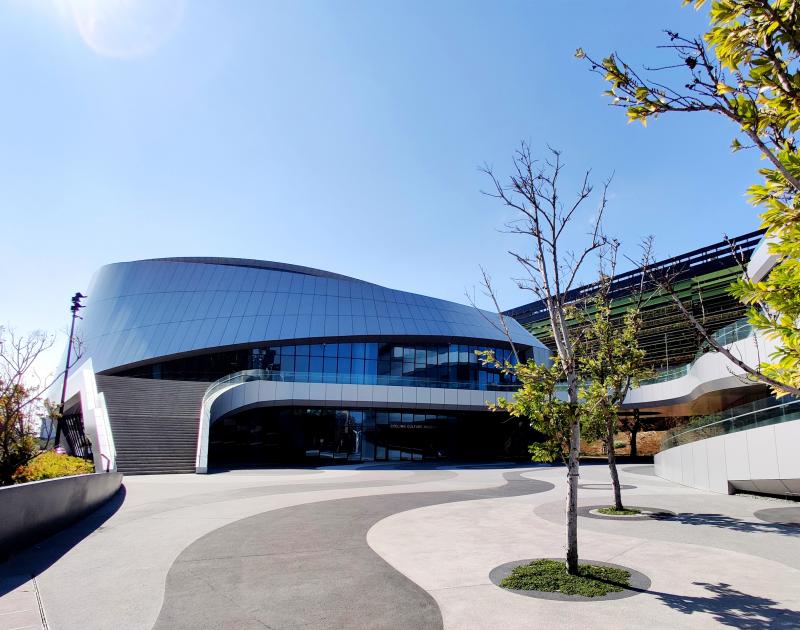
Photo: Mark Caltonhill
Which is just as well, since the 30 or so visitors per day, even paying NT$400 per head for entry plus an optional NT$100 for an audio guide, are unlikely to make much of a dent into the costs of keeping the lights on and the interactive, floor-to-ceiling, virtual-reality cycling displays running.
EARLIEST ORIGINS
Split into eight sections over two floors, with the Tour de Cafe on the third, the museum begins with exhibits introducing 200 Years of Cycling. These start with a copy of the 1817 Laufmaschine, really a precursor of a bicycle since, although it has two wheels, relied on riders to propel themselves by running.
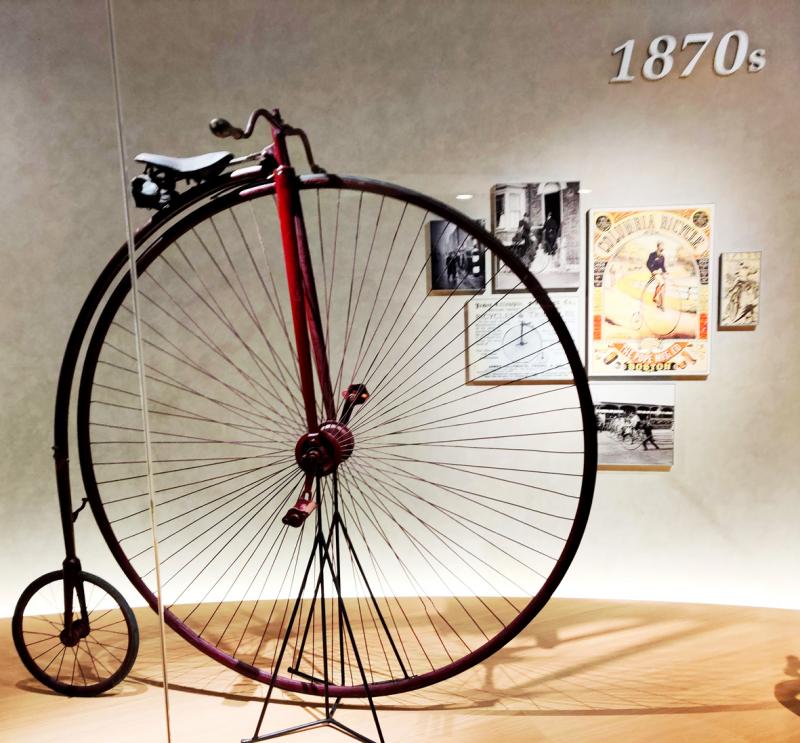
Photo: Mark Caltonhill
Frenchman Pierre Lallement added pedals in the 1860s; the penny-farthing of the 1870s enabled faster speeds by drastically increasing the size of the front wheel; this was swapped to the back in the 1880s for greater stability, especially when going downhill; and the first modern bicycle with chain, gears and the characteristic diamond-shaped frame appeared in the 1890s.
Many so-called museums in Taiwan have got around the problem of how not to run at a deficit by essentially being company product showrooms dressed up as exhibition halls. On entering the CCM’s second room, which introduces Giant’s development from an OEM manufacturer of BMX bikes to one of the world’s most sought-after brands, one’s heart sinks momentarily in case all these millions were really spent on selling yet more Giant bicycles.
Also displayed are a number of Liu’s own bicycles on which he made his iconic round-island ride aged 73 despite “not being a cyclist,” and an even longer ride from Shanghai to Beijing at even more advanced age.
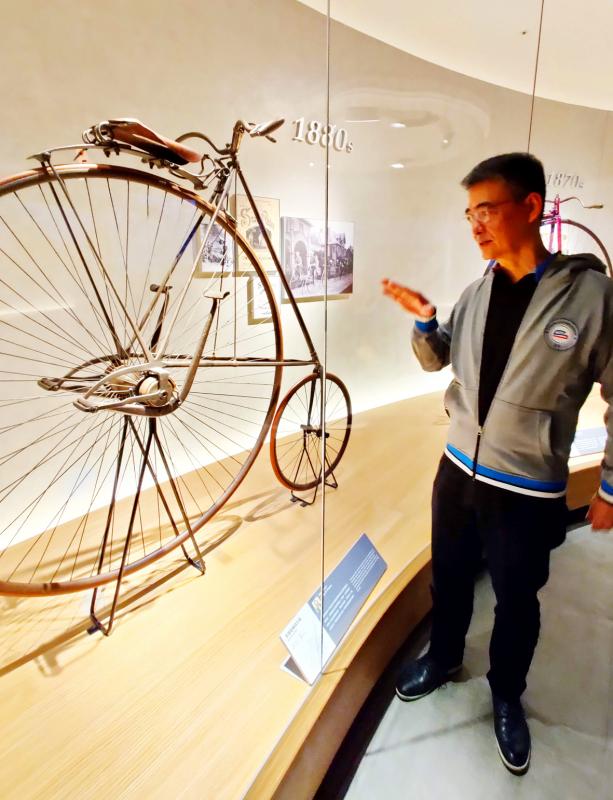
Photo: Mark Caltonhill
Fortunately that is pretty much the end of the self-promotion. For those interested in the science of cycling and bicycle development, the third room 3 is probably the high point of the tour. In easy-to-understand displays augmented with hands-on experimental exhibits, it introduces everything from aerodynamics, friction and gravity, to the influence of the gyroscopic effect (apparently the spinning wheels actually help you stay upright) and caster effect (which improves cornering).
Next up is the development of materials from the wood of the Laufmaschine, through steel and aluminum, to today’s ideal but far-too-expensive titanium and more accessible carbon fiber. Processing of this last is introduced in detail, from butting and bending to hydraulic pressing. There is even a mock-up of a loom, where the 200-300 fibers of a road bike and 400-500 fibers of a mountain bike are woven together before being oven cooked.
TAKING ON THE PROS
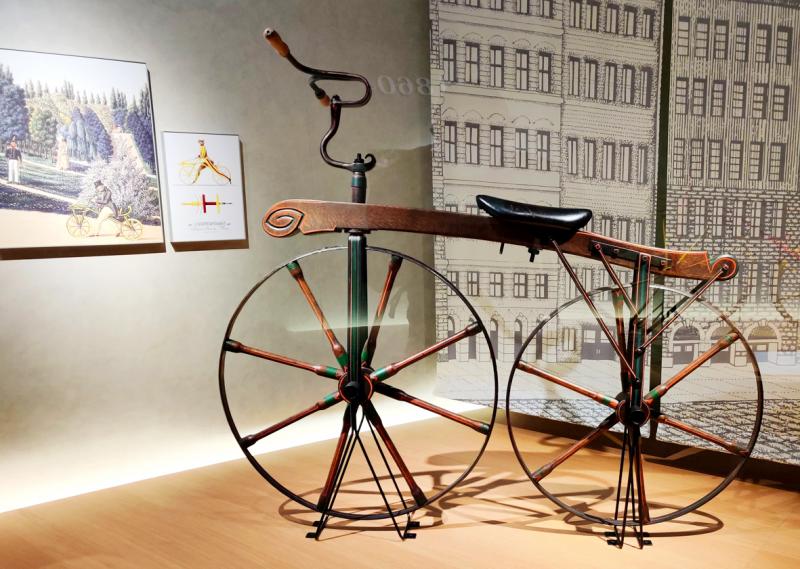
Photo: Mark Caltonhill
Visitors can compete with friends and even professionals to design their own frames, which are then analyzed using Computer Aided Engineering to see how they perform for stiffness, weight, wind drag and vertical compliance.
The fourth room covers the 100 years of racing, focusing on the three Grand Tours, including the Tour de France where Giant has been a sponsor since the 1980s, despite running afoul of UCI rules by making “bikes that were too competitive,” says Wang. This year will be the first that the company does not have a bike in the Tour unless one can be found soon, says Curating Executive Sherry Tsou (鄒珮暄), who also doubles as English-language docent when required.
A side room is furnished like a coach on which professional racers travel, sleep, shower and cook. Further details include their equipment and clothing, and their nutritional requirement of around 6,000 kcals per day.
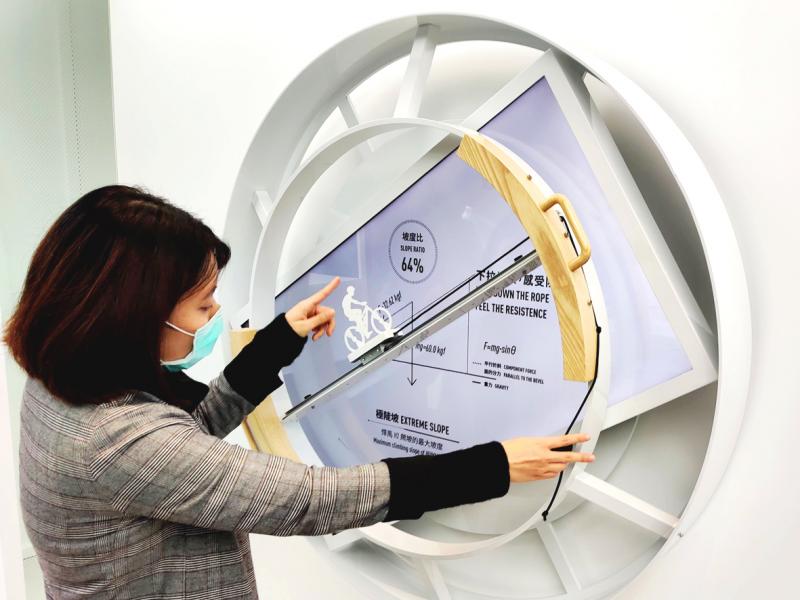
Photo: Mark Caltonhill
Here too are the six virtual reality machines, where visitors can experience the thrills of racing in one of the iconic Grand Tours. Riders will be graded, and told whether they are best suited to team leader, KOM specialist or sprinter, or perhaps to providing support and drafting for stronger contenders.
Similar videos are provided in room five upstairs, though this time they are for trail and mountain bike routes recommended by some of the world’s top off-roaders. The history of such cycles’ development from modified beach cruisers in the 1970s is of interest, and visitors can have their photos taken on bikes in a green room which are then superimposed on pictures of breath-taking exploits.
Room six introduces personal fitting of bicycles to take in unique physical features as well as different cycling requirements. Particular attention is given to recent innovations that take women’s bodies into account, including, but not limited to, pelvic bone structure.
Other trends such as e-bikes and indoor trainers to encourage wider take up of cycling are featured, as well as promotion of cycling as a response to climate change.
This leads, in Room seven, to policies adopted in bike-friendly cities around the world such as Amsterdam, Copenhagen and Portland, which can be copied or modified in locations around Taiwan. This includes the YouBike system modeled on such programs elsewhere, in which Taipei is now a world leader with, the exhibit says, the highest usage rate per bicycle anywhere.
Finally, the eighth room is a movie theater where a 10-minute, grazes-and-all film introduces the beauty of cycling in Taiwan. It certainly makes the viewer want to get outside and on a bike.
As King Liu is quoted at the end: “Driving is too fast, walking is too slow, riding is the best way to enjoy the most beautiful scenery in life.”
ark Caltonhill bikes, and writes, and writes about bikes.

June 23 to June 29 After capturing the walled city of Hsinchu on June 22, 1895, the Japanese hoped to quickly push south and seize control of Taiwan’s entire west coast — but their advance was stalled for more than a month. Not only did local Hakka fighters continue to cause them headaches, resistance forces even attempted to retake the city three times. “We had planned to occupy Anping (Tainan) and Takao (Kaohsiung) as soon as possible, but ever since we took Hsinchu, nearby bandits proclaiming to be ‘righteous people’ (義民) have been destroying train tracks and electrical cables, and gathering in villages

Dr. Y. Tony Yang, Associate Dean of Health Policy and Population Science at George Washington University, argued last week in a piece for the Taipei Times about former president Ma Ying-jeou (馬英九) leading a student delegation to the People’s Republic of China (PRC) that, “The real question is not whether Ma’s visit helps or hurts Taiwan — it is why Taiwan lacks a sophisticated, multi-track approach to one of the most complex geopolitical relationships in the world” (“Ma’s Visit, DPP’s Blind Spot,” June 18, page 8). Yang contends that the Democratic Progressive Party (DPP) has a blind spot: “By treating any

This year will go down in the history books. Taiwan faces enormous turmoil and uncertainty in the coming months. Which political parties are in a good position to handle big changes? All of the main parties are beset with challenges. Taking stock, this column examined the Taiwan People’s Party (TPP) (“Huang Kuo-chang’s choking the life out of the TPP,” May 28, page 12), the Democratic Progressive Party (DPP) (“Challenges amid choppy waters for the DPP,” June 14, page 12) and the Chinese Nationalist Party (KMT) (“KMT struggles to seize opportunities as ‘interesting times’ loom,” June 20, page 11). Times like these can

Swooping low over the banks of a Nile River tributary, an aid flight run by retired American military officers released a stream of food-stuffed sacks over a town emptied by fighting in South Sudan, a country wracked by conflict. Last week’s air drop was the latest in a controversial development — private contracting firms led by former US intelligence officers and military veterans delivering aid to some of the world’s deadliest conflict zones, in operations organized with governments that are combatants in the conflicts. The moves are roiling the global aid community, which warns of a more militarized, politicized and profit-seeking trend